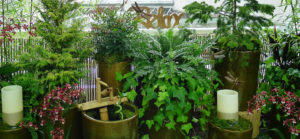 Houseplants can be common or uncommon, and it has nothing to do with the kind of plant you choose for your space. Instead of selecting a houseplant and plunking it in a sunny spot, it’s time to rethink ways to use houseplants as part of the interior design.
Houseplants can be common or uncommon, and it has nothing to do with the kind of plant you choose for your space. Instead of selecting a houseplant and plunking it in a sunny spot, it’s time to rethink ways to use houseplants as part of the interior design.
Houseplants add so much to the indoors we need to treat them like the green treasures they are. They clean the inside air to help us breathe easier, they add a sense of calm, and plants help boost our happiness quotient. Houseplants can also add style to any room in the house.
Now’s the time to start shopping for houseplants at Nick’s to light up the indoors during winter. When browsing the houseplant aisles, pay attention to the different types of plants to imagine what will work best in your space. There are climbing and trailing plants, bushy and upright plants, flowering potted plants, ferns and palms, cacti and succulents, miniature trees, air plants, and pint-sized plants for dish gardens and terrariums.
No matter which kind of houseplants you choose, think about the ways you can turn the display into an indoor garden. One key to success for becoming your own plant interior decorator is by following the landscape design concepts of balance, focal point and color.
BALANCE
Balance means the plants are in proportion to the space and to the other houseplants. Choose plants that are similar in size, form and texture. For example, place all cactus plants together instead of mixing spiny plants with those that have smooth leaves.
Another example of balance is repeating themes of plants. Air plants are perfect for creating a set of similar, yet different-looking plants. A series of dish gardens or terrariums in different sized containers adds interest, as does a lining up plants in identical containers on a windowsill.
Balance can also mean similar shaped plants in pots of different sizes placed on a bookshelf or coffee table, as if they’re collectibles. An especially attractive display is hanging four identical houseplants on a wall in place of a single painting or framed photos.
FOCAL POINT
In the landscape, a focal point is either a plant or a structure that draws you into the garden. This idea can also apply to houseplants that lend an architectural feel to your space.
A houseplant with tall tree-like foliage or a large hanging plant can be a spectacular specimen plant that adds drama to a room.
A focal point houseplant is the kind that can fill an empty space or corner to make a room feel smaller and cozier. Matching topiaries by an entry way focuses attention as soon as guests walk in the front door.
COLOR
Flowering plants are typically responsible for color in the garden, and they can be placed in the indoor garden as well. Indoor blooming plants, like orchids, provide splashes of color when placed among other houseplants.
When adding flowering plants to the indoor garden, choose several of the same variety and place them together in groups. Repeating themes of plants is what makes outside gardens attractive to the eye, and that works for the indoor garden, too.
For a special decorator-like touch, look for plants with colorful foliage that complement the tones in your home. For example, take a cue from colorful throw pillows to match plants with burgundy, purple or gold-tinged foliage.
Another way to ensure color with houseplants is to mix and match the different leaf colors. Select a few plants with dark green leaves, some with light green leaves, and toss in a few with variegated leaves to bring your indoor garden to life.


